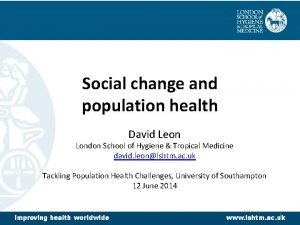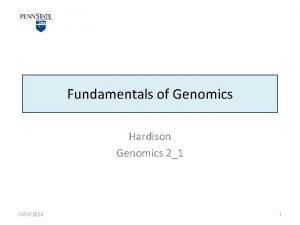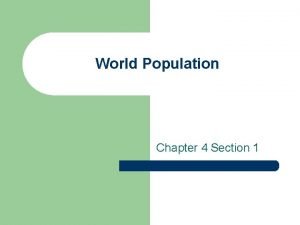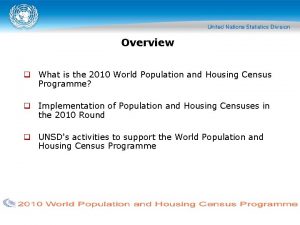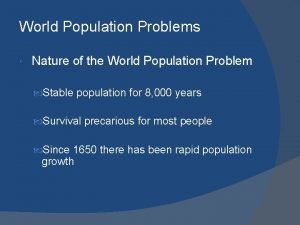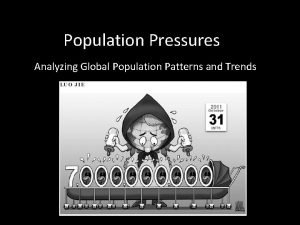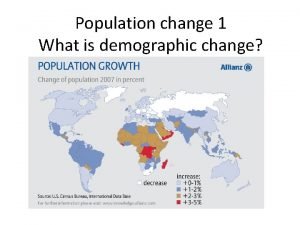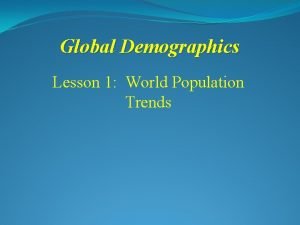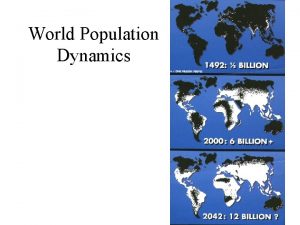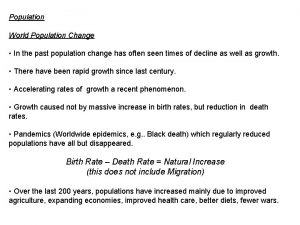Preston High School CGW 4 UI World Population











































- Slides: 43

Preston High School CGW 4 UI World Population: Growth & Trends

In order to understand the world population we must understand the different ‘worlds’ of population growth. They are closely tied to economic development

‘SETTING THE STAGE’ Advance Economies = Developed Countries DC MDC Transition Economies = Newly Industrialized NI BRIC Less Developed Economies = Developing Countries LDC LEDC Least Developed Economies = Third World LDC LEDC

Developed Country • Low birth rate • Most of the people are over 15 years of age • Long life expectancy • Low infant mortality rate • Most people live in urban areas (cities) • High per capita Gross Domestic Product • High literacy rate • Highly industrialized • People make a living in secondary or tertiary economic activities Developing Country • High birth rate • Most of the people are less than 15 years of age • Low life expectancy • High infant mortality rate • Most people live in rural areas (country side) • Low per capita Gross Domestic Product • Low literacy rate • Little industry • People make a living in primary economic activities.

Take away concepts • Why is population growth so central to environmental problems? • What is the current population? What will it be in 2050? • What factors affect population growth rates? • How do growth rate compare in developed vs. developing countries? • What is a "demographic transition? What are its stages? • Interpreting Population Pyramids. • Understanding modern demographic trends.

Why Population is so important • Thomas Malthus (1798) • Organism populations increase exponentially, whereas the “environment” is “fixed” (actually decreases). • Factually correct, but a complex problem. . . • Modern example: high populations AND high quality of life

Malthus’ 1 st Axiom v“The power of population is indefinitely greater than the power in the earth to produce subsistence for man. ” v“Population, when unchecked, increases in a geometrical ratio (exponentially). Subsistence increases only in an arithmetical ratio (linearly). ”

World Population: 7 billion As of Sept. , 2009 (Super)exponential growth

Some observations. . . Pre-19 th century growth rates were ~0. 2%/yr <1 billion people. Pop. doubled in 300 yr. 140 million died of plague: 6 th, 14 th, and 17 th centuries. Replaced in a few centuries. Population increased after Renaissance Modern era population explosion: post-1960

Exponential Growth J curve Population growth after 1800’s ranged 1. 2 -1. 9%! – Super-exponential growth Post-1960 was first time EVER that population doubled within a generation

Population by 2050: 9 billion

Toward “logistic growth” S curve Levels off eventually population time

Factors affecting Growth Rate Growth rate = Birth Rate - Death Rate 1. 3% = 2. 2% - 0. 9% (today) Of these the Birth Rate is the most important contributor, specifically the Fertility Rate (#children/woman) Why? Because death rates have stabilized. . .

Factors affecting Birth Rate Global BR = 2. 2% (95% in developing countries). Lessons on population control from Thailand, South Korea, Japan, India, and China: – Invest in Family Planning – Reduce poverty – Elevate the status of women

Factors affecting Death Rate Global DR = 0. 9% (higher in LDC vs MDC) Low death rates due to: – – medical treatments, better food supplies and nutrition, improvements in sanitation, and access to clean water Lower DR is the main reason for the global population increase

INFANT MORTALITY When infant mortality rates rise…. Population actually increases Why?

ANSWER • For many parents in the developing world their only sense of old age security is their offspring. • If the death rates are high when their babies are born, they must have more children to ensure the survival of a son to care for them

Population Projections Current ~6. 8 billion (and rising), growth rate: 1. 2% (and falling…). Projected 2050 population: 9 billion Using modern growth rate: Calculated pop. by 2050: ~12 billion.

Calculating Doubling Times The “Rule of 70”: – Doubling time = 70/percentage growth rate – (… comes from ln(2) = 0. 69) Example: – Current growth rate is 1. 3%, so doubling time is 70/1. 3 = 54 years (ca. 2060). – Projected pop at 2060 would be ~13 billion – But this won’t be the case… why?

Carrying Capacity At the heart of this issue is the concept of Carrying Capacity (K) – the maximum number of individuals that the environmental resources of a given region can support. Population growth and Carrying Capacity coevolve. – Factors: Technology, social, political, economic institutions, physical & ecological environment.

Carrying Capacity Physical carrying capacity = “packing density”, limited only by space and resources Cultural carrying capacity is always less Still there is a large difference of opinion regarding how many people the earth can support. Accepted range for K is 10 -20 billion people

Where people live

Population growth rates


Demographic Transition Refers to the impact of economic development on birth and death rates. Responsible for the gradual reduction in pop growth rates during the late-20 th century First noted by demographers for changes in 19 th-century Europe, the DT is a critical shift in population growth and age structures that differentiate developed nations from developing nations

Four stages of DT 1. 2. 3. 4. The Preindustrial Stage when there is little population growth because harse social conditions lead to both high death and high birth rates. The Transitional Stage, when industrialization begins and health care improves, resulting in lowered death rates, but birth rates remain high. Most of the developing world here. The Industrial Stage, when the birth rate drops due to modernization (and its accompanying social changes). Many developed countries and a few developing countries here. Finally, the Postindustrial Stage is recognized by further reductions in birth rates, approaching or even below zero population growth. Approximately 13% of the world population (mostly European countries) is in this stage. A complete DT exhibits both declining birth and death rates

Demographic Transition When is the period of maximum population growth rate?

Demographic Transition Stage 1: Death rates and birth rates both high. Stage 2: Fall in death rates, Population increases. Stage 3. Decline in birth rate stabilizes population. Stage 4. Birth and death rates both low, population stable. Stage 5 (new). Higher death rates than birth rates, populations contract.

2) Transitional Stage 2. 9% growth rate; 4. 8 births/woman; 43% population under 15 yrs

Why is this group so important? Largest segment of population today. . “bottom billion” - world’s poorest Will be even larger in near future because most of population is under childbearing age (<15 yrs).

Population Momentum (also population lag effect) Phenomenon that population will continue to grow for decades even after total fertility rates equal only the replacement rate. . . Due to weighting of age structure towards the young… So, work toward zero population growth. . .

3) Industrial Stage 1. 9% growth rate

4) Early Postindustrial 0. 1% growth rate; 1. 8 births/woman; 18% of population under 15 yrs

4) Late Postindustrial -0. 1% growth rate; 1. 2 births/woman; 14% population under 15 yrs

Population Pyramids for the four demographic transition phases

China’s past and future population pyramid

Post-industrial woes of low fertility Fewer young support increasing old Reduced workforce Population decline Significant socioeconomic impacts.

Four questions of the UN Population database 1. 2. 3. 4. Developed vs. developing world Demographic transitions (1960 -2003) Health or Wealth first for prosperity? Demographic impact of HIV-AIDS

Reducing population growth Successful efforts to reduce population growth by Japan, China, South Korea, Thailand, and Iran. These countries were able to achieve replacement-level fertility (enough children born to replace death of parents) within 15 -30 years - this is good news. Key Factors were: – Invest in Family Planning – Reduce poverty – Elevate the status of women

Views from Joel Cohen’s 1995 book “How Many People Can the Earth Support? ” 1. Make a bigger pie: Increase human productive capacities through technology and innovation. 2. Put fewer forks on the table: Reduce numbers and expectations of people through such means as family planning and vegetarian diets. 3. Teach better manners: Change the terms of people’s interactions through improved planning and government to enhance social justice.

The most effective, lasting means for reducing population growth is/are: a) b) c) d) e) Forced family planning compliance Invest in family planning Reduce poverty Elevate the status of women Answers b, c, and d

Demographic Impact of HIV/AIDS Impact on life expectancy HIV infection rates

UN Millennium Development Goals UN Millennium Declaration, Sept. 2000 Adopted by 189 countries By 2015: 1. 2. 3. 4. 5. 6. 7. 8. Eradicate extreme poverty & hunger Universal primary education Gender equality, empower women Reduce child mortality Improve maternal health Combat HIV/AIDS and other diseases Environmental sustainability Global partnership for development
 My blueprint wrdsb
My blueprint wrdsb Xschool cgw
Xschool cgw Self-esteem needs
Self-esteem needs Eden boys school preston
Eden boys school preston Eden school preston
Eden school preston Chapter 4 population ecology test answer key
Chapter 4 population ecology test answer key Section 1 population dynamics
Section 1 population dynamics Population ecology section 1 population dynamics
Population ecology section 1 population dynamics Population ecology chapter 4 answers
Population ecology chapter 4 answers Preston curve
Preston curve Preston medical library
Preston medical library Besos wealth
Besos wealth Schoolscape
Schoolscape Preston university islamabad
Preston university islamabad Sean preston london
Sean preston london The dred scott decision
The dred scott decision Sonia adamson
Sonia adamson James preston green
James preston green Nick preston senator
Nick preston senator Ana preston
Ana preston Battle's sign
Battle's sign Preston mason
Preston mason Preston curve
Preston curve Preston hardison
Preston hardison Crescenta valley high school summer school
Crescenta valley high school summer school Assignment in spanish
Assignment in spanish World population clock
World population clock Guided reading activity 4-1 world population
Guided reading activity 4-1 world population Intj and istj
Intj and istj 1914 world population
1914 world population World's population
World's population 2010 world population
2010 world population Cartogram world population
Cartogram world population Physiological density
Physiological density World population by continent
World population by continent World population by age
World population by age What's the world's population
What's the world's population World population prospects
World population prospects World population
World population World population
World population High precision vs high recall
High precision vs high recall High precision vs high recall
High precision vs high recall Directive and supportive leadership
Directive and supportive leadership High expectations high support
High expectations high support









